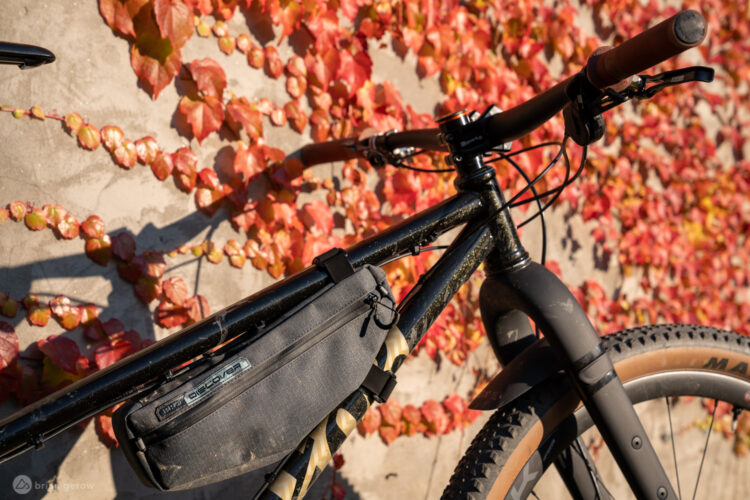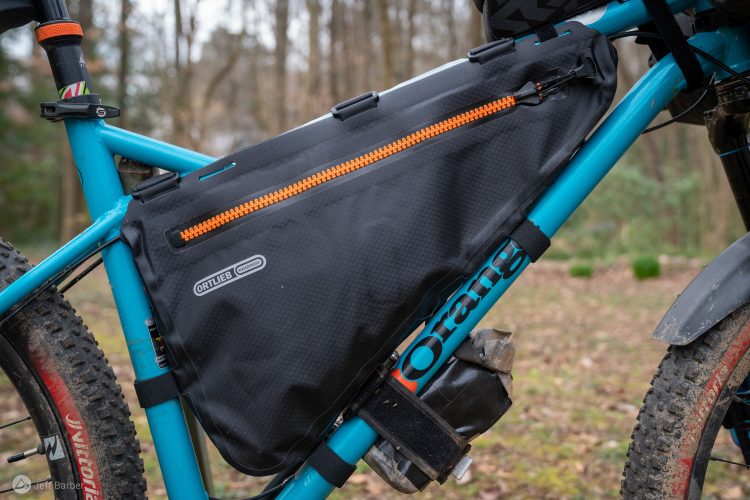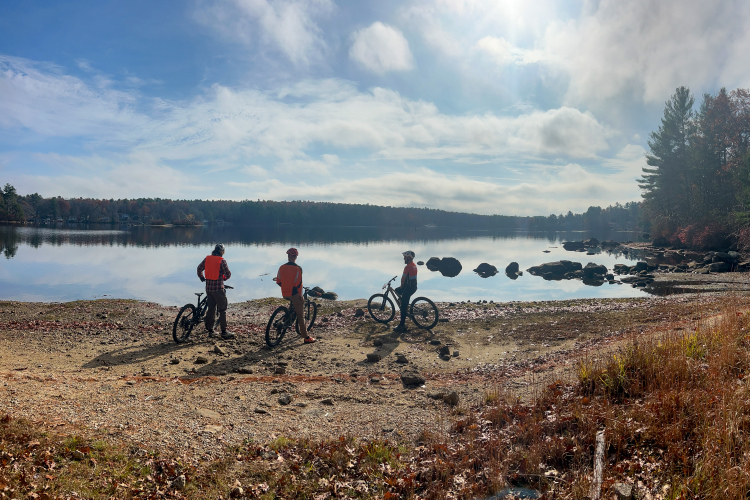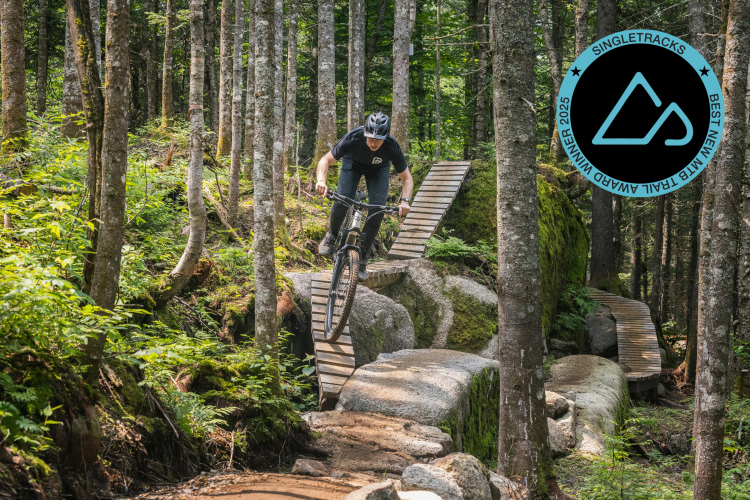
The Camelbak M.U.L.E. line of on-bike packs trace their roots to the popular Camelbak M.U.L.E. line of hydration backpacks that’s remained one of the brand’s best sellers over the years. Like the M.U.L.E. hydration packs, the Camelbak on-bike bags offer mid-size carrying capacity and are chock full of useful off-road features. Unlike the hydration packs where the rider is the mule, the on-bike packs turn your bike into the mule, which I found to be much more comfortable.
Camelbak M.U.L.E. On-Bike pack key specs



Camelbak M.U.L.E. frame pack
The M.U.L.E. frame pack is offered in two sizes to accommodate the dimensions of your bike’s front triangle. To be safe I ordered the size small frame pack because I wanted the option of running it on my gravel bike or my mountain bike. I found the actual measurements to be a bit larger than 40cm x 18cm x 5cm as stated online, though obviously the pack is flexible and can be stretched and squished a bit in any direction.
For a long time, frame bags were bespoke items, with each bag cut and sewn to fit particular frame dimensions. But over the past couple of years, big brands like Camelbak, MEC, and REI have introduced frame bags that can be bought off the shelf. It’s convenient, yes, but the tradeoff is finding the right fit and maximizing available frame space.
With the Camelbak M.U.L.E. frame pack on my “gravel” bike shown at the top of this review there’s obviously a lot of extra space left over, and I could have easily fit the size large pack. There’s an attachment point on the left side of the pack for strapping to the bike’s seat post, but that won’t reach on this bike. The good news is the pack is quite stable using the three mount points I was able to reach (top tube, down tube, and head tube), though it does look a little odd.

On my size extra large hardtail mountain bike, the fit isn’t perfect either, and after a bit of experimenting, I found a way to make it work. Initially, I tried pushing the pack closer to the head tube, but that scrunched the pack and made it bulge out at the sides too much. Farther down the top tube, as shown above, provides a better fit. Riding rough singletrack trails is no problem with the pack, and it’s as secure as any I’ve tested. But again, it looks odd.


The Camelbak M.U.L.E. frame pack comes with a 2L Quickstow reservoir. This is one of the more interesting reservoirs that the brand offers because it includes a screw cap that doubles as a squirt valve for drinking. You can also connect the included hose using the Quicklink connection, which is simple and mostly leakproof. The idea is that the hose can be used to drink from the reservoir on the bike, and then the reservoir can be used as a hydration flask at camp. An included clip attaches the hose to your bars or frame to keep it within easy reach, and the bite valve has a nice on/off lever to prevent accidental discharges.
With the reservoir inside its zippered compartment, there’s not a lot of room left, but it is still enough to fit small essentials like a phone, tool, packable jacket, and snacks. Two mesh pockets help organize everything inside. On the other side of the pack, there’s another zippered compartment that’s weatherproof, though it’s pretty slim and best reserved for flat items like your phone, wallet, and bar snacks.
At $140 for the size small and $150 for the size large, the M.U.L.E. is on the pricey end of frame packs, though that price does include the 2L Quickstow reservoirm which retails for $50 by itself. It would be nice to have the option to purchase the pack with and without the reservoir. My size small test sample weighs 335g with the empty reservoir and hose.

Camelbak M.U.L.E. handlebar bag
I’ve been jealously eyeing others’ handlebar bags for bikepacking as an alternative to the handlebar roll. The Camelbak M.U.L.E. handlebar bag (420g) won’t fit sausage-shaped sleeping gear as easily as a handlebar roll, but it’s more convenient than a frame bag or seat bag when it’s time to stash or grab food or layers on the trail.
Camelbak has added some useful features to the M.U.L.E. handlebar bag, like a mesh pouch on the right side for holding a can of Coke or a water bottle and a zippered pocket on the right for smaller can’t-lose items like keys or a phone. The roll-top closure is waterproof-rated and cinches down using two buckled nylon straps.


All told, there’s 12L of storage capacity in the bag with reflective accents to boot. The flat bottom opens up a lot of carrying possibilities, from a four-pack of beer to a small puppy (top open, of course). You could easily fit 2-3 days’ worth of clothing for an overnight trip, plus a bivy and compact air mattress if you’re into fastpacking.
I tested the Camelbak M.U.L.E. handlebar bag on both my mountain bike and gravel bike. On the mountain bike, the biggest challenge was getting the straps and bag secure without interfering with brake hoses and control cables. However, once I worked everything out, the bag proved to be mostly secure on rough trails, with just a little bouncing that I couldn’t fully tune out.

Fitting the bag on my gravel bike was more straightforward. On this bike, the key was folding the roll top so that the sides of the pack don’t flare out. A metal bracket attached to the pack ensures stability and keeps the pack off the bars just enough to leave all the hand positions open.
Share your Camelbak M.U.L.E. On-Bike review
Camelbak includes all the hardware you need to attach the pack to a flat bar or drop bar bike. The two Voile-style nylon straps make for a tight fit, while the hook-and-loop straps protect your bars and help you position things in place. Two shock cords with notched cord locks add stability by wrapping around the stem and head tube.

I found that all of the included straps and cords were way longer than necessary, at least for my bikes. I ended up cutting some of the hook and loop straps—hopefully I don’t regret it later. I decided not to cut the nylon straps that hold the bag closed since they have sewn ends, but I just can’t imagine needing them to be so long, even with the pack overstuffed. There really isn’t any sort of strap management, so I needed to come up with some creative tie-offs to keep the straps from flapping in the wind.
The Camelbak M.U.L.E. handlebar pack makes for a tight fit with a GPS on my gravel bars and is totally in the way of a bar-mounted light. Mounted on a mountain bike, the wider, flat bars leave more room for accessories at the edges.
Pros and cons of Camelbak M.U.L.E. On-Bike packs
Pros
- Quality materials and design
- Versatile reservoir included with the frame pack
- Good attachment system, though some straps are too long
- Handlebar bag has big capacity that’s easy to access
Cons
- No option to purchase the frame pack without the reservoir
- Only two frame pack sizes so bike fit can be hit or miss
- Handlebar bag is heavy and doesn’t leave a lot of room on some drop bar cockpits
Bottom line
Back in 2012 Singletracks readers voted the Camelbak M.U.L.E. as their favorite hydration pack, and the M.U.L.E. line of on-bike packs is a worthy follow-up. While these packs wouldn’t be my first choice for a long-distance bikepacking trip, they offer a great way to get weight off your back and expand carrying capacity for all-day rides or even credit card touring.










0 Comments